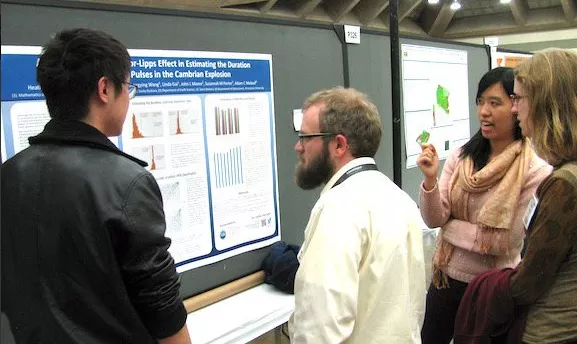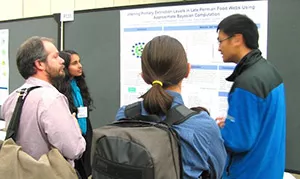Faculty, Students Present Research at Annual Gathering of Geoscientists

Heather Zhou '16 and Daniel Wang '17 explain their statistical paleontology research at the Geological Society of America Conference.
In November, Associate Professor of Statistics Steve Wang and five students joined geoscientists from around the world, representing 37 disciplines, in presenting their work at the Geological Society of America Conference in Baltimore, Md.
Leonie Cohen '16, a biology and anthropology major from Conshohocken, Pa., presented research on when in history Old World monkeys (Cercopithecoidea) and apes (Hominoidea) diverged, which she estimates was about 31 million years ago. This was an exciting finding because her fossil-based estimation corroborated molecular-based findings, which is rare.

Leonie Cohen '16 explains her research on primate evolution.
The conference allowed Cohen to meet in person the third co-author of the paper she and Professor Wang had been working on, as well as many other big names in evolutionary biology.
“It was really great being exposed to different people at different places in their careers," she says. "It was nice being able to get a feel for their experiences and how they enjoy the work that they’re doing at the moment. It was a bit overwhelming, but it confirmed my aspirations of pursuing a Ph.D. after college."
Brandon Chow '17 and Meghana Ranganathan ['17]’s project attempted to determine the cause of the end-Permian mass extinction, which is the largest extinction of life in the history of the world. They used Approximate Bayesian Computation (ABC) to find out how many species went extinct during this period, which might shed some light on how they went extinct.
“The best part of the conference was the discussions we had at the poster sessions with other experts in the field," says Ranganathan, a math major from Addison, Tex. "They asked questions about our research and also offered insight into other data sets we could explore and how to interpret the results we already have.”
Ranganathan thought the most interesting aspect of their research was their use of ABC, a relatively new method which has not been used widely in paleontology. “If we can show that this method works," she adds, "it could open a lot of doors to making other difficult questions easier to answer.”

Brandon Chow '17 and Meghana Ranganathan '17 explain their statistical paleontology research.
Heather Zhou '16 and Daniel Wang '17 focused their research on the exact opposite of mass extinction: mass origination. They looked at the Cambrian Explosion, which is the first time most animal groups appear in the fossil record. They used a dataset of 166 fossils from Mongolia, Siberia, and China to estimate how long the Cambrian Explosion took and found that it took around 20 million years.
In their research, they had to account for the Signor-Lipps Effect, a paleontological principle that states that because the fossil record is never complete, the first or last animal in a mass origination or extinction are not necessarily fossilized. This makes paleontologists more likely to assume a mass origination or mass extinction was shorter than it truly was.
Daniel Wang, a math major from Wilmington, Del., found the experience eye-opening. “This was my first conference and the thing that really struck me was the scale of it," he says. "I met people from all around the world," including some, he says, who are involved in studies on water pollution and nanotechnology for moon probes.
Professor Wang, who develops statistical methods to study evolution and extinction in the fossil record, is proud of the work he and his students presented. “The conference is the biggest annual gathering for my area of paleontology," he says, "so it’s a great place to learn about new research and to have a wide audience see your work.”



